
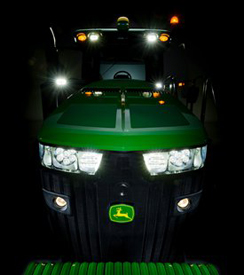 Premium lights
Premium lights
The 7R, 8R, and 8RT Series Tractors feature two lighting package options:
The cab lighting pattern provides 330 degrees of coverage while the hood lighting provides the remaining 30 degrees for completely programmable 360-degree, stadium-style lighting. This ensures there are no dead zones or lighting adjustments needed. The lighting configurations are available to match various applications and ensure maximum around-the-clock productivity.
Bulb housings are large, allowing for optimum total lumens and available light. The standard lighting packages use 65-W halogen bulbs, whereas the premium lighting package uses light-emitting diode (LED) lights. In the premium lighting package, these tractors take advantage of the high-performing and efficient LED technology.
The low- and high-beam driving/work lights are adjustable. Please refer to the electrical section in the operator’s manual for complete details on adjusting lights.
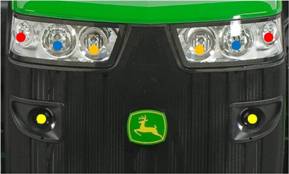 7R/8R/8RT lighting
7R/8R/8RT lighting
Yellow circles
Red circles
Blue circles
Orange circles
|
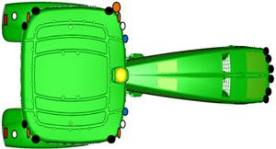 Standard lighting (8R)
Standard lighting (8R) Standard lighting (7R)
Standard lighting (7R)Six front grill-mounted lights:
10 cab roof-mounted lights:
Other lights:
Plus these lights:
Eight front grill-mounted lights:
12 cab roof-mounted lights:
Other lights:
The premium lighting package replaces all previous halogen and HID lights with LED lights. The only lights that are not LED are the low-beam driving lights, they remain halogen. This allows each LED light to work at a lower temperature and no one light works harder than any other. The uniformity in LED coverage allows only one type of light output surrounding the tractor.
The lighting pattern in the premium package provides industry-leading performance in nighttime visibility. LED bulbs provide maximum brightness and a true color output for excellent field definition that is easy on the operator's eyes.
The LED lights provide 40 percent greater coverage width and 10 percent more light coverage in the rear. LED lighting packages use 45 percent less amps than standard halogen lights and have an increased life expectancy over HID lights which leads to lower costs of ownership over the life of the tractor.
NOTE: Lighting packages may vary depending on region.
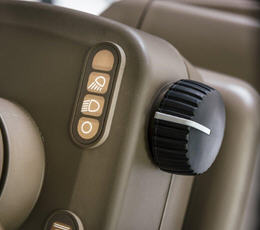 Lighting mode selector
Lighting mode selector 
Operators can quickly select a lighting mode on the steering console:
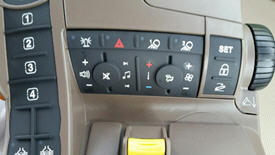 The CommandCenter™ display
The CommandCenter™ displayThe CommandCenter display allows operators to customize light settings. Operators can select only the lights they need or want for a given application and store these settings. The operator-programmed configurations can then be turned on or off with the push of a button on the CommandARM™ controls.
NOTE: Road/loader lights are also referred to as high-mounted driving lights for use in front hitch applications that obscure the headlights. See the Attachments section.
The battery power saver feature is also standard. When the engine is off and the outside lights have been left on, this feature is designed to avoid battery run down.
After the lights have been left on for 30 minutes and the key is in the off position, the lights cycle or blink on and off five times as an alert. The lights continue to illuminate for one more minute and then automatically shut off to protect the battery.
Field-installed options are also available. To find this information, use the Build Your own Configurator application for US/Canada or Build & Price in John Deere Sales Centre for Australia/NZ.
Another feature is programmable exit lighting. Exit lighting allows the lights outside the cab to stay on for up to 300 seconds. They can be programmed in increments from 0 to 300 seconds.
Refer to the operator’s manual for complete instructions on programming field, driving, and exit lighting.
| Option code | Description |
| 7201 | Standard lighting |
| 7206 | Premium lighting |
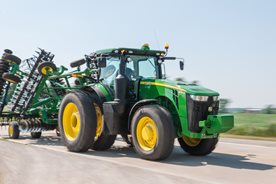 8R in transport
8R in transport
With ACS, John Deere has designed one of the most robust and full-encompassing steering system in the industry. Whether in the field or on the road, ACS reduces steering effort, which can result in reduced operator fatigue and can improve operator comfort.
There are four key features of the ACS system:
Dynamic road wheel offset:
Variable ratio steering:
Elimination of steering slop and hand wheel drift:
Variable effort steering:
The ACS system is fail operational, which means steering is still functional in the event of any single-point failure. John Deere has gone to great lengths to help ensure the operator has the ability to steer the tractor if something goes wrong in the steering system.
For example, if the primary controller fails, a second controller takes over. If power from the alternator fails, the battery resumes control. If the engine quits running and is unable to supply hydraulic oil to the system, an electric-driven backup pump is used to supply the oil. There is a backup for ACS components.
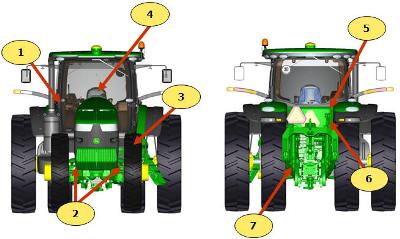 ACS components
ACS components
The ACS system consists of several key components:
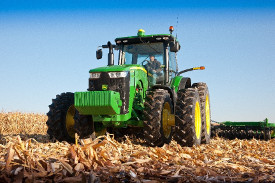 8R Series Tractor equipped with ILS
8R Series Tractor equipped with ILS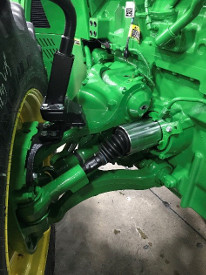 Close-up view of ILS design
Close-up view of ILS designThe John Deere ILS utilizes industry-leading technology to supply unsurpassed gains to end-user productivity. This innovative design incorporates proven suspension design with mechanical front-wheel drive (MFWD) axle components that use state-of-the-art technology specifically for heavy equipment usage.
The ILS front axle is available on all 8R Series Tractor models.
Feature | ILS |
Hydraulic differential lock | Yes |
Limited slip | No |
Suspension | Yes |
Brakes | Yes (optional on 42 km/h [26 mph]) |
Tire ratio/steps allowed | 5 or 6 |
Duals | Yes |
Tread spacing singles* | 1574 mm - 2184 mm |
Tread spacing singles | 1524 mm - 2235 mm |
Singles with duals | 1524 mm - 2235 mm |
Duals | 2946 mm - 3658 mm |
Top speed | 42 km/h (26 mph) or 50 km/h (31mph) depending on model |
Front power take-off (PTO) | Optional |
* Based on wheel equipment shipped to some geographic regions.
The ILS system gets more power to the ground because the front tires maintain ground contact pressure. This improves field and transport ride plus increases ballasting flexibility and drastically decreases the tendency to power hop.
 ILS cutaway
ILS cutawayThe ILS axle maintains minimum oil levels in the front differentials to assist in providing overall tractor operating efficiency.
John Deere ILS has three systems:
Mechanical system
The mechanical system is further broken down into the mechanical drive system and mechanical suspension system.
The mechanical drive system includes:
The mechanical suspension system consists of large cast, upper- and lower-control arms with cast steering knuckles for durability and reliability.
Hydraulic system
The hydraulic system consists of suspension cylinders, a control valve manifold, a front differential lock, and hydraulic accumulators.
Electrical system
The electrical system contains position sensors, solenoids for the control valves, and a master controller for complete automatic control of the ILS system.
How does it work?
The mechanical, hydraulic, and electrical systems work together to maintain a level and vertically-centered position of the front differential case in relation to the outboard hubs and planetaries, independent of tractor weight or dynamic loading. The system's ability to maintain a vertically centered position provides full suspension travel of 25.4 cm (10 in.). This translates to consistent soil contact for improved power to the ground as well as dampens the energy from bumps that cause a rough ride.
The tractor utilizes electronic and computer controls that monitor tractor functions and axle position. Based on those inputs, the electrical system automatically triggers hydraulic functions to raise, lower, or remain static.
The John Deere ILS uses a short/long A-arm design, which means the upper control arms are shorter than the lower control arms. During wheel movement, the upper control arm moves in a smaller arc than the lower control arm, and the difference in the two arcs creates a change in camber. The change in camber helps keep the inside and outside of the front tires perpendicular to the drive surface, a very important feature when optional front dual wheels are installed. This design provides anti-dive characteristics to naturally reduce the adverse effects of braking and acceleration.
The John Deere ILS front axle has been specifically designed to accommodate additional options, such as front 3-point hitches and front duals. To properly handle these options, large steering cylinders and knuckles provide up to twice the steering capacity of the standard MFWD beam axles so steering performance is maintained. A simple steering stop arrangement offers infinite adjustability for fine-tuning in any row spacing.
Braking system
With higher speeds and expected heavy towed implements and carts, front brakes are optional on 42-km/h (26-mph) ILS-equipped tractors and part of base equipment on 50-km/h (31-mph) ILS-equipped tractors. The braking system is applied proportionally between the front and rear axle brakes to effectively stop the tractor. There are no operator adjustments or requirements to operate the additional braking system.
Tire compatibility
For travel speeds of 50 km/h (31 mph), B-speed-rated tires that provide high-speed capabilities are required.
With the ability to have a six-step drop from rear to front tire, the 8R equipped with an ILS axle is able to have group 49 rear tires with group 43 fronts. This allows for the benefits of group 49 tires while maintain the turning radius allowed by group 43 front tires.
NOTE: The use of group 44 tires for front duals does not allow for some row crop spacings.
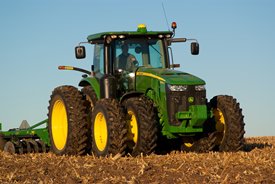 8R Series Tractor with front duals
8R Series Tractor with front duals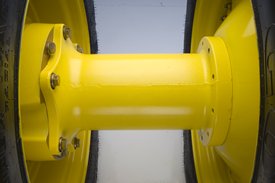 Narrow-diameter extension and hub attachment
Narrow-diameter extension and hub attachmentFront dual tires provide:
Hitch application
In hitch applications, it is important to maintain at least 50 percent of the ballasted front-axle weight (with implement raised) for steering control. Referring to the example below, the maximum ballasted weight of the front axle is 7756 kg (17,100 lb). If the tractor has a hitch-mounted implement, when the tractor is weighed with the hitch and implement fully raised, the front weight must be at least 3878 kg (8550 lb). The front axle capacity is directly proportional to the weight that can be carried on the hitch.
The MFWD axle has a front weight carrying capacity equal to the front tire carrying capacity. For example, in row-crop applications using the popular 480/70R34 (155 load index) front tires, the highest load rating is 3878 kg (8550 lb) per tire with a total of 7756 kg (17,100 lb) at maximum tire pressure. This means (depending on tire pressure and speed) there is as much as 3878 kg (8550 lb) available for support of rear implements in transport.
Maximum load carrying capacity of the axle is determined by the load carrying capacity of the tires and whether the tractor is equipped with singles or duals.
Additional ILS features:
There is no on/off switch for ILS operation since the John Deere advanced electronic management system knows when to disengage ILS automatically. The electronic controller will activate a restricted mode of operation, when any of the following conditions are met:
Based on the inputs received (speed, suspension displacement, braking and operator input to hitch and/or remote cylinders), the tractor determines when the system should be active or inactive, making operation simple and efficient.
Shortcut keys on the CommandARM enable the operator to engage or disengage MFWD on the go, even under full load, without stopping or clutching. The switch can be placed in one of the following positions:
1. AUTO
2. On
3. Off (brake assist)
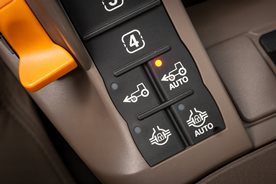 AUTO light
AUTO lightWhen this light-emitting diode (LED) light is lit, MFWD is on but automatically disengages when either of the following conditions are met:
As with the brake-assist position, when both brakes are depressed, the MFWD automatically engages (if not already on) to provide four-wheel braking.
 Automatic MFWD angle adjustment
Automatic MFWD angle adjustment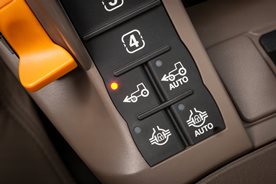 MFWD light
MFWD lightWhen this LED light is lit, MFWD engages continuously.
Mode 3 MFWD off (brake assist)
When no LED lights are lit, the MFWD is off. This is also referred to as the brake-assist position. Even though the MFWD is disengaged, when both brakes are pressed at speeds above 5 km/h (3 mph), the MFWD engages to assist braking the tractor.
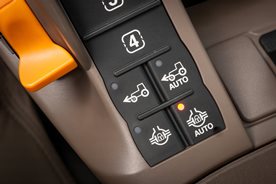 CommandARM™ controls with automatic differential lock engaged
CommandARM™ controls with automatic differential lock engaged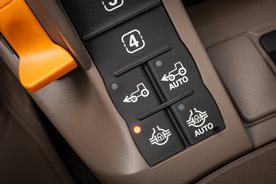 CommandARM controls with manual differential lock engaged
CommandARM controls with manual differential lock engagedThe differential lock is another feature of the ILS axle. When the rear differential lock is engaged or disengaged, the front differential lock is also engaged or disengaged. This also includes a driveline shield.
If one wheel begins to slip, the differential lock can be engaged on the go and the axles are hydraulically locked together for maximum traction. There are two ways to engage the differential lock feature.
 Automatic differential lock angle adjustment
Automatic differential lock angle adjustmentAdditional equipment for use with ILS axle
All 8R and 8RT Series Tractors come standard with an 85-cc displacement integrated hydraulic pump. This pump provides 227.1 L/min (60 gpm) of hydraulic flow.
A dual-pump option, featuring 85-cc and 35-cc displacement hydraulic pumps, is available for all 8R wheel models. The dual-pump system provides a hydraulic flow of 321 L/min (85 gpm), ideal for running at lower engine speeds.
SCV flow (approximate) | ||
Engine rpm | Pump flow (85-cm3 pump) L/min (gpm) | High pump flow (85-cm3 pump + 35-cm3 optional pump) L/min (gpm) |
800 | 86 (23) | 122 (32) |
1500 | 162 (43) | 229 (61) |
1700 | 184 (49) | 260 (69) |
1900 | 206 (54) | 290 (77) |
2100 | 227 (60) | 321 (85) |
Operating the tractor at reduced engine rpm contributes to a quieter cab, reduced fuel usage, and maintains the vacuum while turning and raising the planter on end rows. At 1500 erpm with a 321 L/min (85 gpm) system there will be an available flow of 229 L/min (61 gpm). This is an improvement over an available 162 L/min (43-gpm) flow when operating with a 227 L/min (60 gpm) system at 1500 erpm.
The maximum flow through one selective control valve (SCV) with a standard coupler is 132 L/min (35 gpm). A 19.1-mm (3/4-in.) high-flow coupler allows for a maximum flow rate out of one SCV of 153 L/min (40.5 gpm).
The hydraulic system is a closed-center, power-on-demand system using a load-sensing pressure-flow compensated axial piston pump with full-flow charge and flow prioritization for steering and brakes.
The pump outlet pressure available on demand can range from 3000 kPa (435 psi) for track models and 4000 kPa (580 psi) for wheel models at low standby to 20,400 kPa (2958 psi) at high standby.
Hydraulic pump options:
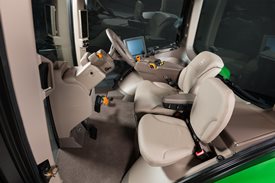 CommandView III cab
CommandView III cabThe Standard CommandView III cab offers unsurpassed visibility, operator comfort, control placement, and ride and sound quality.
Features:
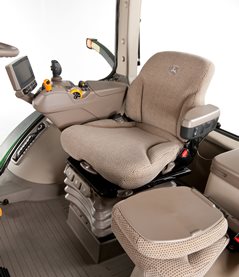 ComfortCommand seat
ComfortCommand seatComfortCommand seat improves ride quality and helps to reduce operator fatigue.
Features include:
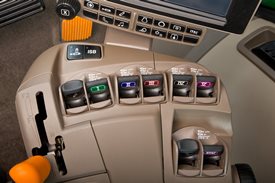 Fingertip paddle pots
Fingertip paddle pots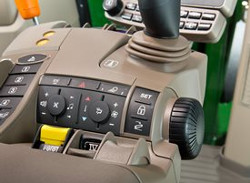 Encoder wheel
Encoder wheel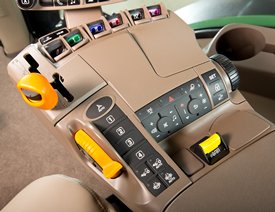 CommandARM controls
CommandARM controlsJohn Deere 7R and 8R Series Tractors feature the CommandARM with integrated Generation 4 CommandCenter display. The control layout of the CommandARM utilizes a clean and efficient design which groups controls by function and builds upon John Deere’s history of intuitive and ergonomic control placement and operation. The design of the CommandARM allows for a 40 degree right seat swivel and adjustable positioning matching the operator’s preference.
Controls located on the CommandARM include:
John Deere 7R Series Tractors with CommandQuad transmissions feature a left-hand reverser. 8R Series Tractors equipped with 16-speed PST are equipped with right-hand reverser. 7R Series Tractors equipped with e23 PST offer a left- or right-hand reverser. 7R or 8R Series Tractors equipped with AutoPowr™/IVT transmissions are offered with either a left-hand or a right-hand reverser.
The transmission control lever is placed on the left side of the CommandARM closest to the operator for convenient setting and adjustment.
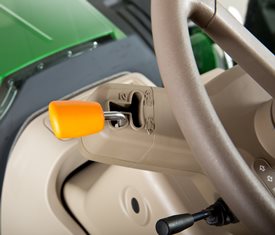 Left-hand CommandQuad/e23 reverser
Left-hand CommandQuad/e23 reverser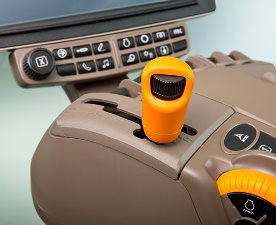 Right-hand IVT and PST reverser
Right-hand IVT and PST reverser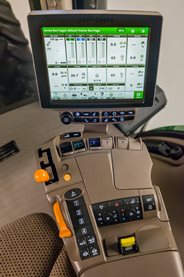 16-speed PST right-hand reverser
16-speed PST right-hand reverserHydraulic and hitch controls utilize fingertip paddle pots for raise/lower and extend/retract functions. An optional crossgate joystick replaces fingertip paddle pots for control of SCVs and allows for programmable hydraulic functionality according to operator preference. Rear hitch position can also be controlled with the encoder wheel located on the right side of the CommandARM. The encoder wheel allows for finite positioning of the rear 3-point hitch.
Three buttons near the encoder are for hitch set, lock, and return to height. Adjustment knobs for the 3-point hitch are located under the cover for the CommandARM control's storage compartment and allow for adjustment of the rate of drop, hitch height limit, and depth control.
 Hitch controls
Hitch controls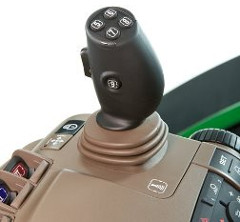 Optional crossgate joystick
Optional crossgate joystickThrottle
The throttle design incorporates buttons which control FieldCruise speed, foot pedal mode (if equipped), and transmission eco settings.
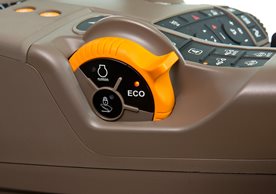 Throttle
Throttle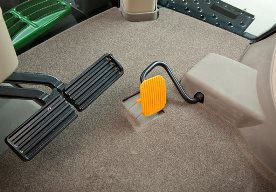 Foot throttle
Foot throttleTractor function controls
Located just to the right of the throttle is the AutoTrac activation button and four sequence controls for iTEC functions. Behind the iTEC sequence controls, there are buttons which control the activation and deactivation of MFWD and differential lock.
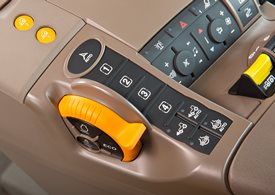 AutoTrac resume and iTEC strip
AutoTrac resume and iTEC stripControls for radio, lights, rotary beacon (if equipped), hazard flashers, and HVAC system are located to the center-right on the CommandARM, along with PTO for both front (if equipped) and rear PTO.
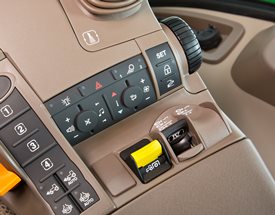 Radio, HVAC, hazard flashers, and PTO controls
Radio, HVAC, hazard flashers, and PTO controlsSeat swivel
The design of the CommandARM allows for up to 40 degrees of right-hand seat swivel.
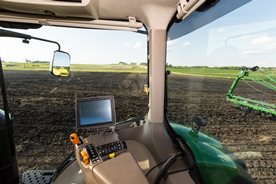 Seat swivel
Seat swivel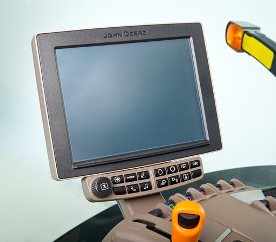 Generation 4 CommandCenter
Generation 4 CommandCenterThe Generation 4 CommandCenter features fast adjustment of tractor functions and controls and are integrated into the CommandARM to create a seamless control center. The 4100 CommandCenter features a 178-mm (7-in.) touchscreen display and is standard equipment on 7210R and 7230R models, while the 4600 CommandCenter features a 154-mm (10-in.) touchscreen and is standard equipment on 7250R – 7310R models, as well as all 8R and 8RT models.
The following functions can be adjusted using the CommandCenter display:
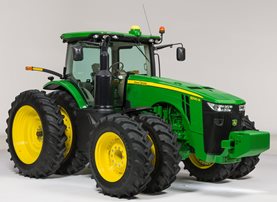

John Deere 8R Series Tractors are utilized in numerous applications that place different demands on tires. As such, multiple tire offerings are available for 8R Series Tractors to accommodate a wide range of grower needs. Tire options provide variability in terms of ground clearance, tread width, and floatation to match different operating conditions.
John Deere sources 8R Series Tractor tires from the following major brands:
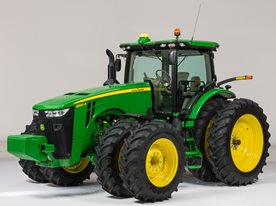 8R Series Tractor
8R Series Tractor
Front and rear tires for 8R Series Tractors are sized and combined under different group sizes based on tire rolling circumference. All front tire options for 8R Series Tractors are classified as group 42, 43, or 44, while all rear tires are classified as group 47, 48, or 49. The approximate overall diameters for each group are shown in the following table.
| Group | Overall diameter |
| 42 | 1498 mm (59 in.) |
| 43 | 1600 mm (63 in.) |
| 44 | 1676 mm (66 in.) |
| 47 | 1955 mm (77 in.) |
| 48 | 2057 mm (81 in.) |
| 49 | 2172 mm (85.5 in.) |
For tractors with mechanical front-wheel drive (MFWD) or Independent-Link Suspension (ILS™) front axles, there typically needs to be five steps (or group size difference) between the front and rear tires to maintain proper tire overspeed between axles. This means the group 42 front tire needs to be matched with group 47 rear tire, and group 43 front tire needs to be matched with group 48 rear tire.
On 1500 MFWD axles, four-step combinations between front and rear tires are also acceptable (determined at the time of ordering the tractor). This means group 44 front tire can be matched with group 48 rear tire, or group 43 front tire can be matched with group 47 rear tire. Six step combinations are possible on tractors equipped with ILS, allowing group 43 front tires to be paired with group 49 rear tires in order to maintain narrower tread functionality with row crop width tire options.
Additionally, tires have a load index rating designed to report the load carrying capability of the tire.
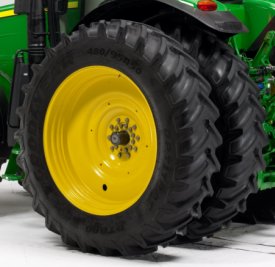

John Deere 8R Series Tractors are now approved for group 49 rear tires. Group 49 tires have a larger diameter and longer footprint, which results in greater traction in most field conditions compared to smaller group size tires of the same section width and basic design. Group 49 tires also provide a larger air volume than comparable smaller group sizes, which can help control power hop in some conditions.
NOTE:
Multiple tire options are available for 8R Series Tractors to accommodate multiple applications or row widths. Refer to the minimum recommended row widths for tire options based on the row-width requirements in the following table.
NOTE: Not all tires listed in the chart are available on all John Deere tractors. See your local John Deere dealer for assistance in choosing the proper tires for specific tractor models.
Rear tires | Minimum recommended row width | |||||||
508 mm | 559 mm | 762 mm | 813 mm | 1016+ mm | ||||
Rear tire section width | ||||||||
RCI Group | Approximate outside diameter | 320 mm | 380 mm | 480 mm* | 520 mm* | 620 mm | 710 mm (28.0 in.) | 800 mm (31.5 in.) |
49 | 2175 mm |
|
| 480/95R50 |
|
| 710/75R42 |
|
48 | 2057 mm | 320/105R54 | 380/90R54 | 480/80R50 | 520/85R46 | 620/70R46 650/85R38 | 710/70R42 | 800/70R38 |
47 | 1956 mm | 320/90R54 | 380/90R50 | 18.4R46 480/80R46 | 20.8R42 520/85R42 | 620/70R42 650/75R38 | 710/70R38 |
|
*480 and 520 width tires will accommodate minimum tread setting of 33 in. with 85L oil takeout.
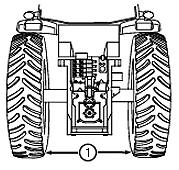 Tread spacing
Tread spacing
To prevent draft link interference, the distance (1) between the inside edges of the tires should be:
* Tires 480 mm (19 in.) and larger may not be able to reach all tread settings. Refer to the operator’s manual for detailed tread setting limitations.
Goodyear is a trademark of Goodyear Tire and Rubber Company.
Firestone is a trademark of Bridgestone Americas Tire Operations, LLC.
Michelin is a trademark of MNA, Inc.
Mitas Tires North America is a registered subsidiary of MITAS a.s.
Trelleborg is a trademark of Trelleborg Wheel Systems, Inc.
| Front tires | Minimum recommended row width | |||||||
| 508 mm (20 in.) | 559 mm (22 in.) | 762 mm (30 in.) | 813 mm (32 in.) | 1016+ mm (40+ in.) | ||||
| Front tire section width | ||||||||
| RCI Group | Approximate outside diameter | 290 mm (11.4 in.) | 320 mm (12.6 in.) | 380 mm (15.0 in.) | 420 mm (16.5 in.) | 480 mm (18.9 in.) | 520 mm (20.5 in.) | 620 mm (24.4 in.) |
| 44 | 1676 mm (66 in.) | 540/75R34 | 620/75R30 | |||||
| 43 | 1600 mm (63 in.) | 320/80R42 | 380/80R38 | 420/85R34 | 480/70R34 | 540/65R34 | 600/70R30 | |
| 42 | 1499 mm (59 in.) | 320/85R38 | 380/85R34 | 16.9R30 420/90R30 | 480/70R30 | 540/65R30 | 600/65R28 | |
Please reference the operator’s manual for tread spacing requirements.
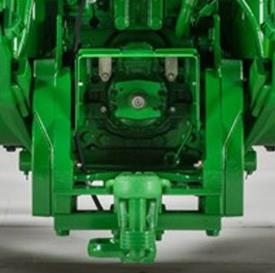 45-mm (1-3/4-in.), 1000-rpm PTO
45-mm (1-3/4-in.), 1000-rpm PTOAll 8R and 8RT Series Tractors come standard with a fully independent 45-mm (1-3/4-in.), 1000-rpm PTO. This 20-spline shaft is designed for high-power, heavy PTO loads that require full horsepower above 150 PTO hp.
The 8R Series Wheel Tractors offer additional mechanical and electrical speed-change PTO options to provide the versatility and flexibility needed to satisfy implement demands. An in-cab shiftable, eco version of the 45-mm (1-3/4-in.), 1000-rpm PTO is available, allowing full PTO rotations at decreased engine speeds.
Additionally, a 45-mm (1-3/4-in.), 1000-rpm PTO capable of 35 mm (1-3/8 in.), 540-rpm (6 spline)/1000-rpm (21 spline) can be ordered. To field convert to the 35-mm (1-3/8-in.) 540/1000-rpm PTO, a field kit is required (the required shaft is dependent on the hitch option).
NOTE: 540-rpm PTO options are not compatible with the Category 4 drawbar.
The PTO activation switch is located on the CommandARM™ controls. In addition, PTO engagement modulation is adjustable with settings located in the CommandCenter™ display. The PTO shaft can be slightly rotated or indexed to aid in PTO drive hookups. All PTO options feature internal lubrication with heavy-duty oil-cooled clutch plates. A PTO safety start system and seat-activated PTO warning is standard on all 8R and 8RT Series Tractors.
The following tables show when shaft kits are required for each PTO shaft based on the selected hitch option (drawbar, 3-point hitch, 80-mm ball/piton).
1000/540 PTO | ||||||
| PTO type | Nominal diameter, mm | Number and type of splines | PTO speed (rpm) | Drawbar | 3-point hitch | 80-mm ball/piton |
| 1 | 35 | 6 straight splines | 540 | RE272736 | RE272736 | R538037 |
| 2 | 35 | 21 involute splines | 1000 | RE272736 | RE272736 | R537791 |
| 3 | 45 | 20 involute splines | 1000 | OK from factory | OK from factory | OK from factory |
1000/1000E PTO | ||||||
| PTO type | Nominal diameter, mm | Number and type of splines | PTO speed, rpm | Drawbar | 3-point hitch | 80-mm ball/piton |
| 1 | 35 | 6 straight splines | 540 | No solution | No solution | No solution |
| 2 | 35 | 21 involute splines | 1000/1000E | R537790 | R537790 | R313423 |
| 3 | 45 | 20 involute splines | 1000/1000E | OK from factory | OK from factory | OK from factory |
General applications:
NOTE: Proper engine speed for the 1000-rpm PTO shaft is 2000 engine rpm. For the 540-rpm PTO shaft, proper engine speed is 1817 rpm.
Rear PTO options:
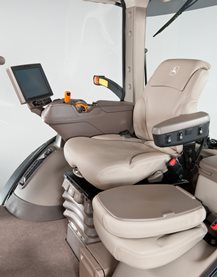 ActiveSeat and controls
ActiveSeat and controls
John Deere’s ActiveSeat utilizes electrohydraulic technology in combination with air suspension, providing the operator with enhanced ride quality over standard air-suspension seats.
Operator movements are monitored in order to reduce vertical movement. An ActiveSeat suspension can isolate the operator from up to 90 percent of vertical movements typically seen in tractor applications.
The system uses a hydraulic cylinder that is connected to a control valve assembly. Electrohydraulic valves located in the control valve assembly automatically react to inputs from two sensors, a position sensor and an accelerometer. Inputs from these two sensors control oil flow from the tractor to the hydraulic cylinder to reduce the vertical movement of the operator.
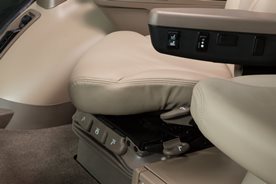 ActiveSeat left armrest
ActiveSeat left armrest
The John Deere ActiveSeat has many of the same features of the ComfortCommand™ seat with the addition of a ride firmness switch. The ride firmness switch is located on the left-hand armrest and replaces the suspension shock-dampening seat attenuation lever on the front right-hand side of the ComfortCommand seat controls.
The ride firmness switch has three positions: plus, minus, and mid position. The three positions provide three different levels of seat performance:
The ActiveSeat is also available as a heated leather seat for increased comfort and easier cleaning. For tractor applications where operating speed is not limited by the implement, the ActiveSeat can allow for faster field speeds and increased overall comfort and productivity.
NOTE: The John Deere ActiveSeat is not available on track tractors.
| Option code | Description |
| 2061 | Premium CommandView III Cab with Active Seat |
The Generation 4 CommandCenter was designed to provide a consistent user experience by providing full-screen viewing of more run page modules, shortcut keys, and precision agriculture capabilities.
Expect easier set-up, along with increased operator confidence, thanks to a simple, customizable interface. The improved design of the Generation 4 CommandCenter also aids in an optimal operating experience and maximizes uptime.
In order to increase your efficiency, take advantage of the following features offered by the Generation 4 CommandCenter:
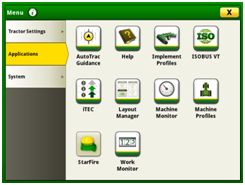 Layout manager selection page
Layout manager selection page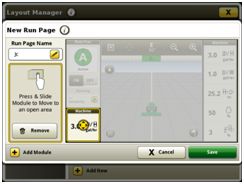 Layout manager module build
Layout manager module build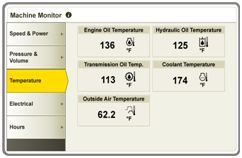 Machine monitor page
Machine monitor page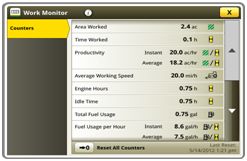 Work monitor page
Work monitor page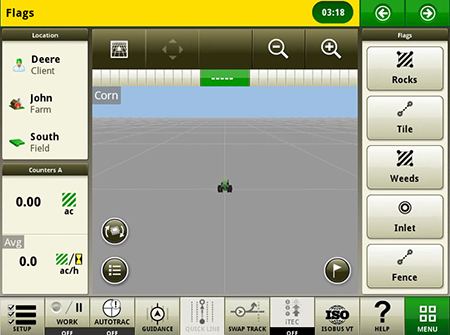 Create flags to mark items in the field
Create flags to mark items in the field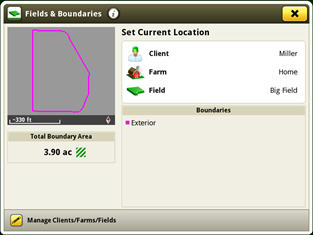 Boundary creation from coverage
Boundary creation from coverage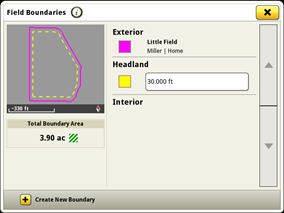 Headland creation
Headland creation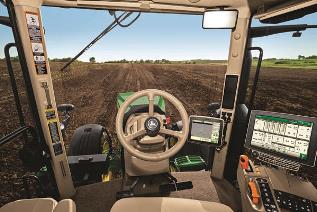 Dual display
Dual displayNOTE: Vehicle applications will always be located on the Gen 4 CommandCenter.
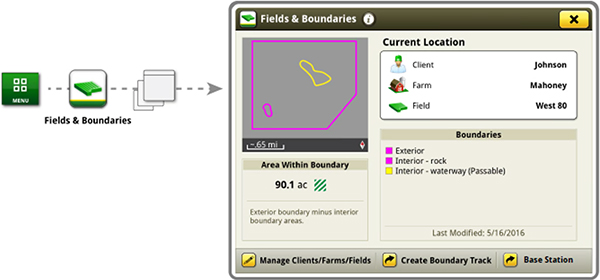 Setup base stations in Fields and Boundaries applications
Setup base stations in Fields and Boundaries applications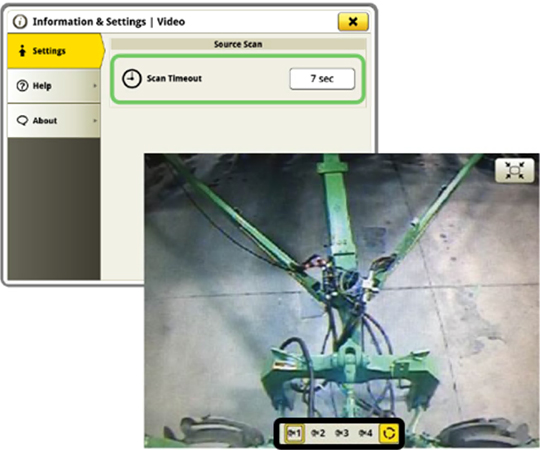 Scan through videos with video looping
Scan through videos with video loopingCompare the specifications of up to 4 models
| Key Specs | 8270r-tractor Current Model |
|---|---|
| Engine description | John Deere PowerTech™ PSS 9.0 L (B20 diesel compatible) |
| Engine displacement | 9 L 549 cu in. |
| Rated engine power | (97/68EC): 199 kW 270 hp |
| Rated PTO power (hp SAE) | 167 kW 225 hp |
| Transmission type | Standard: e23 Powershit with Efficiency Manager™ 40K, 40 km/h 26 mph Optional: 16-speed PowerShift 40 km/h 26 mph e23 Powershift with Efficiency Manager™ 50K, 50 km/h 31 mph John Deere AutoPowr™ IVT™ 40K, 26 mph (0.05-42 km/h) John Deere AutoPowr™ IVT™ 50K, 31 mph (0.05-50 km/h) |
| Hydraulic pump rated output | Standard: 85-cc pump: 227.1 L/min 60 gpm Optional: 85-cc plus 35-cc dual pump: 321 L/min 85 gpm |
| Rear hitch category (SAE designation) | Standard: Category 3/3N: 6,350 kg (14,000 lb) standard lift at 610 mm behind hitchpoint Optional: Category 3/3N: 8,391 kg (18,500 lb) at 610 mm behind hitchpoint Category 4N/3 9,072 kg (20,000 lb) at 610 mm behind hitchpoint |
| Base machine weight | MFWD/PST: 12,680 kg 27,953 lb ILS/e23: 14,270 kg 31,459 lb |
| Maximum PTO power | |
| Maximum engine power | |
| Engine specifications | |
| Description | John Deere PowerTech™ PSS 9.0 L (B20 diesel compatible) |
| Engine type | Diesel, in-line, 6-cylinder, wet-sleeve cylinder liners with 4 valves-in-head |
| Engine family | JJDXL09.0308 |
| Rated speed | 2100 rpm |
| Aspiration | Dual series turbocharger with fixed geometry first stage-variable geometry second stage - air-to-air aftercooling and cooled exhaust gas recirculation |
| Cylinders liners | |
| Emission level | Final Tier 4 |
| After treatment type | DOC/DPF/SCR |
| Displacement | 9 L 549 cu in. |
| Engine performance | |
| Rated power | (97/68EC): 199 kW 270 hp |
| Rated PTO power (hp SAE) | 167 kW 225 hp |
| Power boost | 10 percent |
| Engine peak torque | At 1600 rpm: 1,264 Nm 932 lb-ft |
| PTO torque rise | 40 percent |
| Intelligent Power Management (available in transport and/or mobile PTO applications) | |
| Maximum PTO power | |
| Maximum engine power | |
| Transmission | |
| Type | Standard: e23 Powershit with Efficiency Manager™ 40K, 40 km/h 26 mph Optional: 16-speed PowerShift 40 km/h e23 Powershift with Efficiency Manager™ 50K, 50 km/h 31 mph John Deere AutoPowr™ IVT™ 40K, 26 mph (0.05-42 km/h) John Deere AutoPowr™ IVT™ 50K, 31 mph (0.05-50 km/h) |
| Reverser | |
| Clutch; wet/dry | |
| Creeper | |
| Hydraulic system | |
| Type | Closed-center, pressure/flow compensated |
| Pump rated output | Standard: 85-cc pump: 227.1 L/min 60 gpm Optional: 85-cc plus 35-cc dual pump: 321 L/min 85 gpm |
| Available flow at a single rear SCV | 0.5 in. couplers: 132 L/min 35 gpm 0.75 in. couplers: 159 L/min 42 gpm |
| Available flow at front SCVs | 96 L/min 25 gpm |
| Number of rear selective control valves (SCVs) | Standard: 0.5 in. ISO couplers: 5 Optional: 0.5 in. ISO Couplers: 5 and 6 available 0.75 in. ISO coupler: 2 |
| Number of mid selective control valves (SCVs) | |
| Number of front selective control valves (SCVs) | |
| Joystick SCV control | |
| SCV control | Electronic |
| Rear hitch | |
| Hitch draft control load sense type | |
| Remote control valves available | |
| Hitch category (SAE designation) | Standard: Category 3/3N: 6,350 kg (14,000 lb) standard lift at 610 mm behind hitchpoint Optional: Category 3/3N: 8,391 kg (18,500 lb) at 610 mm behind hitchpoint Category 4N/3 9,072 kg (20,000 lb) at 610 mm behind hitchpoint |
| Maximum lift capacity behind lift points | Standard: 12,124 kg (26,729 lb) at 610 mm behind hitchpoint |
| Sensing type | Electrohydraulic |
| Rear axle differential lock | |
| Lift capacity at standard frame | |
| Drawbar | |
| Drawbar category | Standard: Category 3 Optional: Category 4 Category 4 with heavy duty support |
| Maximum vertical load | 1,837 kg (4,050 lb) - 2,700 kg (6,000 lb) (dependent on drawbar position) Optional: 2,245 kg 4,950 lb Optional: 4,990 kg 11,000 lb |
| Rear power take-off (PTO) | |
| Type | Independent Standard: 44 mm (1.75 in.) 20-spline, 1,000 rpm Optional: 44 mm (1.75 in.), 20-spline, 1,000 rpm capable of 35 mm (1.375 in.) 540/1000 rpm 44 mm (1.75 in.) 20-spline, 1,000 rpm/1,000E rpm |
| Engine rpm (at rated PTO speeds) | 16-speed PST: 1,000 PTO rpm at 2,003 engine rpm 1,000 ECO PTO rpm at 1,596 engine rpm 540 PTO rpm at 1,817 engine rpm IVT: 1,000 PTO rpm at 2,000 engine rpm 1,000 ECO PTO at 1594 engine rpm 540 PTO rpm at 1,814 engine rpm e23 PST: 1,000 PTO rpm at 1,995 engine rpm 1,000 ECO PTO at 1,590 engine rpm 540 PTO rpm at 1,810 engine rpm |
| PTO actuation | |
| Ground speed PTO option availability | |
| Multispeed PTO option availability | |
| Front hitch | |
| Category | Category 3N |
| Electric power | |
| Standard lift capacity | Category 3N ground engaging front hitch: lift capacity: 5,200 kg 11,464 lb |
| Front power take-off (PTO) | 44 mm (1.75 in) 20 spline, 1,000 rpm 35 mm (1.375 in) 21 spline, 1,000 rpm 5 mm (1.375 in) 6 spline, 1,000 rpm (available dependent on location) |
| PTO speed | 1,000 PTO rpm at 2,000 engine rpm |
| Rear axle | |
| Type | Standard: Rack-and-pinion, double flat, or flange axles Optional: Long, single taper hub: Diameter: 110 x 3010 mm 4.33 x 118.5 in. Optional: Long, dual taper hub: Diameter: 110 x 3010 mm Long, dual taper hub: Diameter: 120 x 3010 mm 4.72 x 118.5 in. Short, double flat axle with single taper hub: Diameter: 120 x 2550 mm 4.72 x 100.4 in. |
| Final drive type | Inboard planetary three pinion |
| Differential controls | |
| Axle type | |
| Brakes, type and control | |
| Rear differential lock | Full-locking electrohydraulic |
| Load rating | |
| Front axle | |
| Type | Standard: 1300 Series MFWD Optional: 1500 Series MFWD ILS |
| Front axle differential lock | 1300 Series MFWD: Limited Slip 1500 Series MFWD: Full-locking electrohydraulic ILS: Full-locking electrohydraulic |
| Load rating | |
| Tires | |
| Front | |
| Rear | |
| Wheel tread range | 1300 Series MFWD: 1,524-2,235 mm 60-88 in. 1500 Series MFWD: 1,524-3,657 mm 60-144 in. ILS: 1,524-3,657 mm |
| Turning radius with brakes | |
| Turning radius without brakes | 1300 Series with 380/85R34 group 42 tires at 60 in. spacing, 5.4 m 17.7 ft ILS with 380/85R34 group 42 tires at 60 in. spacing, 5.42 m 17.8 ft |
| Steering | |
| Type | Standard: Hydrostatic power-steering with electric pump back-up Optional: ActiveCommand™ Steering (ACS) with electric pump back-up |
| Electrical system | |
| Alternator size | Standard: 200 amp |
| Battery options | 12 V |
| Total cold cranking amps | 1850 CCA |
| Type of bulb in beacon (Halogen, Zenon, LED) | |
| Type of bulb in headlight (Halogen, Zenon, LED) | |
| Working lights | |
| dB(A) rating for backup alarm | |
| Operator station | |
| Rollover protective structure, OOS | |
| Seat | Standard: ComfortCommand™ Optional: ActiveSeat™ |
| Cab suspension | Optional |
| Instructional seat | Standard |
| Display | Standard: 4100 Generation 4 CommandCenter™ with 7 in. display Optional: 4600 Generation 4 CommandCenter™ with 10 in. display |
| Radio | Standard: AM/FM stereo with weatherband, remote controls, auxiliary input jack, four speakers and external antenna |
| Inner cab volume | 3.597 m3 127 cu ft |
| dB(A) rating | |
| Cab glass area | 6.52 m2 70.18 sq ft |
| Front visibility | |
| Safety glass rating | |
| Dimensions | |
| Wheelbase | MFWD: 3,080 mm 121.3 in. ILS: 3,050 mm 120.1 in. |
| Overall length | 6,636 mm 261.3 in. |
| Drawbar clearance | 376 mm 14.8 in. |
| Front axle center | MFWD: 686 mm 27 in. ILS: 590 mm 23.2 in. |
| Approximate shipping weight, Open;Cab | |
| Overall height | |
| Weight | |
| Base machine weight | MFWD/PST: 12,680 kg 27,953 lb ILS/e23: 14,270 kg 31,459 lb |
| Maximum ballast level | SAE PTO kW: 88.6 kg SAE PTO hp: 145 lb |
| Maximum permissible weight | |
| Capacities | |
| Crankcase oil volume | 1300 MFWD: 25 L 6.6 U.S. gal. 1500 MFWD: 28 L 7.4 U.S. gal. ILS: 27.5 L 7.3 U.S. gal. |
| Fuel tank | Group 47/48: 615 L 162.5 U.S. gal. Group 49: 676 L 178.6 U.S. gal. |
| Diesel exhaust fluid (DEF) tank | 23 L 6 U.S. gal. |
| Cooling system | 32.6 L 8.6 U.S. gal. |
| Transmission-hydraulic system | MFWD: 140 L 37 U.S. gal. ILS: 165 L 43.6 U.S. gal. |
| Serviceability | |
| Interval for engine oil change | 500 hours |
| Interval for hydraulic/transmission oil change | 1,500 hours |
| Interval for engine coolant change | 6,000 hours |
| Loaders | |
| Loader | H480 |
| Lift capacity at full height | 2,486 kg 5,469 lb measured at 800 mm ahead of pivot |
| Maximum lift height | 4,735 mm 186 in. |
| Precision AG | |
| Guidance | AutoTrac Ready |
| Telematic | Available with JDLink™ hardware, activations, and Ethernet Harnesses (availability dependent upon destination) |
| Remote diagnostics | Available with activated JDLink™ hardware and activations |
| Miscellaneous | |
| Country of manufacture | USA |
| Side slope rating | |
| Uphill/downhill slope rating | |
| Tracks | |
| Drive type | |
| Midrollers | |
| Track width | |
| Tread spacing |
© COPYRIGHT 2025 LEGACY EQUIPMENT - ALL RIGHTS RESERVED| Privacy Policy | Powered By